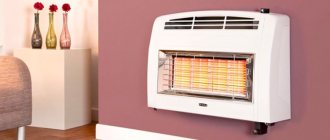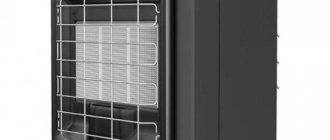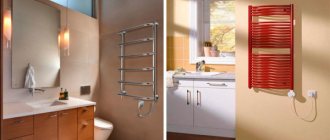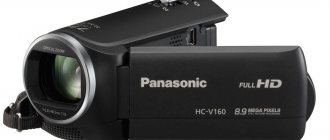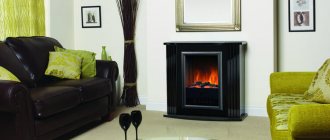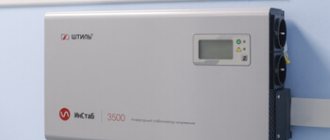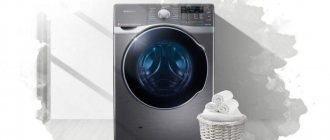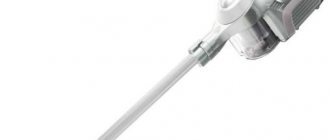When choosing suitable equipment for heating a house or cottage, you should pay attention to inverter-type equipment. The operating principle of such devices is based on the conversion of alternating current to bring them to the required parameters.
Among the differences of an inverter heater are efficiency, low noise level and a small range of temperature fluctuations in the room.
The characteristics of the equipment are superior to infrared and water heating. And before buying, you should get acquainted with the selection criteria and the most popular models.
Criteria for choosing an inverter heater
A gas appliance is more profitable, but more dangerous to operate
The first thing people pay attention to when choosing inverter heaters is power. Productivity is calculated using different formulas. The first is the same as for a conventional heating radiator.
It is assumed that for heating 1 sq. m, 100 W of power is enough. For a 10-meter room you need a 1 kW device, for 20 sq. m – 2 kW. The second method of calculation is by volume.
First, the number of cubic meters is determined, then it is multiplied by the appropriate coefficient. For reinforced concrete panel houses it is 41 W/cubic meter. m. for the rest - 34 W per cubic meter. m.
When choosing an inverter type air conditioner, the main criteria are:
- Manufacturer. The Toshiba and Mitsubishi brands belong to the premium class. Timberk – to medium. Ballu and Electrolux - to the budget segment.
- Energy carrier – electricity or gas. Electric models are most often chosen. A gas appliance is more profitable, but more dangerous to operate.
- Energy consumption. Mitsubishi brand models are characterized by high energy consumption. Toshiba products are considered the most energy efficient.
- Availability of a serial number on the device. This is also a sign of quality technology.
Buyers of equipment should check the availability of certificates and marks of conformity. Products that meet international standards and are safe for health must have such documents and symbols. You can find certificates on the websites of consumer electronics stores.
Types of inverter heaters for home
The most popular inverter heater for home is gas, which runs on natural or liquefied gas. This is the most economical type of such devices - they give off the maximum amount of heat with minimal energy consumption.
The next type is an infrared inverter heater. The principle of operation of such a device is that infrared rays heat not the air itself, but the objects and surfaces it collides with, and these objects already give off heat to the environment. The sun heats the planet using the same principle. This heater will warm up your home well, but it works best in gazebos, patios, or outdoor spaces.
The last type of inverter heaters are ordinary-looking air conditioners, but they additionally have heat pumps installed.
See also –
Are infrared heaters harmful to health or not?
Toshiba RAS-07EKV-EE/RAS-07EAV-EE – quality and reliability
Installation of an inverter air conditioner from the EKV model range will provide heat to rooms up to 20 square meters. m. The design of the model allows it to look good in any interior. The low level of noise generated during operation does not interfere even at night.
To improve ease of maintenance, the instrument panel is made smooth. And the operation of both the indoor and outdoor units is almost silent. The noise level in the serviced premises does not exceed 26 dB.
Other features of the model include a self-cleaning tray and several operating modes. An economical air conditioner consumes no more than 200 W, a normal air conditioner consumes 550 W. There is the possibility of automatic start, operation in drying mode, turbo mode for fast heating or cooling.
Another useful option is a timer that turns equipment on or off at a given time. Information about the operation of the equipment is displayed on the LCD screen, simplifying management.
List of advantages of energy-saving equipment:
- quiet operation of external and internal units;
- ease of use – even an inexperienced user can figure out the settings;
- remembering user-specified settings;
- anti-ice system, which allows you to turn on the equipment even at low outside temperatures.
Flaws:
- length of communications (10 m), which may not be enough for installation in some rooms;
- a price that exceeds the costs of other heaters of similar power.
Main characteristics
The latest inverter heaters operate in automatic mode. When the device reaches the set temperature mark, the system does not turn off, but switches to a reduced power level. Due to this scheme, the room will always have the required level of heat. The equipment is economical and consumes minimal energy, since there is no need to constantly turn the heater on and off.
Based on the principle of operation, an inverter heater for a home is similar to an air conditioner. Its main part is a heat pump with external and internal units. One of them contains a heat exchanger, inside of which freon is formed. Its temperature can rise to 80 degrees, after which it moves to an external unit with a lower pressure. After this, freon is converted from a liquid form to a gaseous state. As a result of this transformation, a large amount of thermal energy is produced.
In this video you will learn how to choose an inverter:
Thanks to this operating principle, the inverter heater is very efficient. It is able to create a comfortable temperature even in a very cold space.
Advantages and disadvantages
A modern electric inverter heater is the optimal solution for the home. The equipment has many advantages:
- Economical. The unit requires a small amount of current to operate. Due to the absence of the need to restart, the device operates for a long time. Compared to other devices, energy savings are 40%.
- Performance and practicality. The device warms even at extremely low temperatures without loss of efficiency.
- Environmental friendliness and safety.
- Almost silent operation. This criterion is achieved by reducing the rotation speed at partial load.
However, each equipment has its drawbacks. This heater was no exception. The inverter has the following disadvantages:
- High price compared to other types of heating systems.
- Sensitivity to sudden changes in voltage.
- Difficulty in selecting spare parts. The parts are not standard, so it may take several weeks to repair the equipment in the service.
Application in heating systems
The inverter device is successfully used in electric heating systems. The invention has a lot of positive reviews. It can be used in any place where there is access to electricity. This equipment can be used without special permission to install a heating system.
Such an inverter can easily replace a gas boiler
The unit is capable of replacing a traditional gas boiler . In this case, the heating system with a built-in inverter device will work as follows:
- Passing through the system, electricity will enter the boiler.
- The inverter boiler will produce an induction current.
- When the power is turned off, the equipment will continue to work thanks to the battery.
- The heater consists of a heat exchanger and a magnetic part.
Timberk TEC.E0 M 2000 – environmental friendliness and safety
The main task of the TEC.E0 M 2000 convector is to heat rooms up to 15-20 square meters. m. Such equipment is worth buying both for use in an apartment, and for a summer house or office. Operational safety is ensured by the presence of a protective sensor.
In addition, the design of the device allows for both wall mounting and floor installation. The kit includes parts for two options - brackets and support legs. You can select the optimal mode using a convenient regulator. The first stage provides a power of 1.2 kW, the second – 2 kW.
Features of the technology include the Heating Energy Balance technology used. It increases the environmental friendliness of using the device and provides instant heating. Acceptable microclimatic conditions will be obtained in just 30-60 minutes after turning on the device.
Other reasons for purchasing include the device’s resistance to voltage surges, light weight, and lack of noise during operation or shutdown. The latter feature allows the device to be used for heating living rooms, including a bedroom or children's room.
Advantages of the technique:
- quiet operation;
- installation on the floor and mounting on the walls;
- lightness – the device weighs only 5 kg;
- compactness – the heater does not take up much space;
- availability of power adjustment;
- reliability of fall protection;
- heating rate.
Disadvantages of the device:
- drying the air during work;
- the length of the cord, due to which the equipment will have to be placed close to the outlet;
- lack of wheels on the legs to move the device.
Inverter heating system in the house. Electricity usage experience and costs
Consumer opinion after 4 months of use.
When choosing a heating system for our house, there were not many options. Trunk gas was planned for our village along the Novorizhskoe highway in the Moscow region, but in a very uncertain future. The gas holder was no longer needed due to lack of space, while all standards for its placement on the site were observed. Therefore, we considered two possible options for electric heating: either an electric boiler and heating radiators or heating with electric convectors with inverter control. Since any owner of a new country property, where there is no gas or its supply costs several hundred thousand rubles, faces this choice, I decided to share my own experience.
The house is located in the Moscow region, 70 km along Novorizhskoye Highway. Permanent accommodation. The house is one-story with a second light, large windows in the living room (living room area 40 sq.m.) Total area of the house is 135 sq.m. meters. The house was built using frame technology, the foundation is piles. When building the house, special attention was paid to the quality of insulation; during construction it was necessary to actually not leave the construction site, continuously monitoring the quality of the insulation work. When using electric heating, the quality of insulation in the frame is a key factor in saving money.
Initially we planned to install heating with an electric boiler. But neighbors’ expenses for heating with an electric boiler in houses of comparable area and wall material are 15,000 -22,000 rubles per month. Not the coldest winter of 19/20 made me think: after all, in our house there are large windows and heat loss should be higher. The prospect is to invest 250,000 - 300,000 rubles in equipment and installation of the boiler, piping, radiators and then pay 20 thousand rubles monthly. our family budget clearly did not suit us.
Therefore, the choice was made in favor of heating the house using inverter-controlled convectors. At least we reassured ourselves that if the energy costs were the same as with the boiler, then at least we would save on equipment and installation, plus there would be no polypropylene pipes along the walls.
In October 2021, I installed 8 Electrolux inverter convectors in my house (ECH/AG2-T with ECH/TUI3 control unit, power from 1 kW to 2.5 kW. We survived the winter of 20/21 with this system and can share experience of use and real calculations on energy consumption.
Here's a house plan:
Inverter heating system components:
Since Electrolux has many different models, the exact article number of the convectors installed in the house is: ECH/AG2-1000T – TUI3. Where the letter "T" indicates that this is the Transformer series. The “transformer” series means that the convector consists of two main components - the heating module itself and the control unit, often they are sold as a set. AG2 is an Air Gate heating module (if there is a letter R, then this is a Rapid model, differing only in design). 1000 is an indicator of the maximum power of the heating element. Inverter control unit TUI3 – (I – inverter, 3 – third generation of control units).
The power of the convectors was selected at the rate of 1 kW for an area of up to 15 sq.m. For the configuration of my house, I got 8 convectors:
1 piece of 1 kW, 4 pieces of 1.5 kW, 1 piece of 2 kW and 2 pieces of 2.5 kW. Each convector is equipped with a digital inverter TUI 3.0 control unit and a wi-fi module.
In total, the entire set (8 heating modules, 8 digital inverter (TUI3) control units and 8 wifi modules) cost about 80,000 rubles.
Installation of inverter convectors
Installation of convectors is very simple - screw two self-tapping screws into the wall according to the supplied template; the kit includes a bracket that clings to the convector and hangs on the self-tapping screws. I did electrical wiring throughout the entire house at the same time, incl. and sockets for convectors. There are no special requirements - you just need to provide separate lines for each convector.
A similar set of equipment using an electric boiler and 8 heating radiators would cost 150-160 thousand rubles. This is the first plus in favor of the heating system using Electrolux inverter convectors
Electricity costs
Now regarding expenses, our electricity tariff is: 4.01 rubles per kWh. Here are all the records on energy consumption in winter 20/21:
This is the second and biggest advantage compared to an electric boiler: winter 20/21 was the frostiest in recent decades. The maximum electricity consumption for heating occurred in January: 2333 kW, which is 9 thousand rubles for permanent residence. I compare with the costs of neighbors in the village - with approximately the same houses, the cost of heating with an electric boiler ranged from 15,000 - 18,000 rubles per month. Moreover, unlike us, who live permanently in a house with a temperature of 21°C, neighbors sometimes visit us when they are not there and the heating is at a minimum.
The third plus in favor of the inverter system: there are no pipes and, for my taste, the design of the convector is much nicer than a boring panel radiator.
Control
Since we live in the house permanently, the desired mode is set manually on each convector. What is convenient about an inverter convector: you set the desired temperature once and then the convector independently monitors the current temperature and smoothly changes the heating power. Unlike conventional convectors, which operate in on/off mode, thanks to inverter control, the heating power of the convector smoothly changes depending on the difference between the current and set temperature.
If there is a need for remote heating control, this can be done through the Hommyn mobile application. In the mobile application, convectors can be combined into groups (for example, three convectors can be combined into a “living room” group), and the group can be managed as a single device. To control via a mobile application, a wifi network is needed in the house.
The display of the control unit goes out a few seconds after setting or changing operating parameters: at night the display does not irritate with a bright glow. Convenient darkened lid to prevent accidental button presses.
Comparison of an inverter system with heating using an electric boiler
What conclusion can be drawn after four months of operation:
- heating system using Electrolux inverter convectors - a complete home heating system, an excellent alternative to heating with an electric boiler with radiators;
- The inverter system is much cheaper in terms of equipment and installation costs;
- The inverter system is significantly cheaper in terms of energy costs.
- System reliability. If the convector breaks down, the house will not freeze. And if the boiler or pump fails, the entire heating system of the house will stop working. And it’s not always possible to quickly solve a problem without the help of a specialist, taking into account the fact that you live outside the city.
- Aesthetics: no white polypropylene pipes on the walls, space saving - no need for a large boiler room.
What made me share my experience of using inverter heating was the fact that when reading various comments on forums, one encounters the same skepticism: any electric heater has the same efficiency: since 1 kW of electricity produces approximately 1 kW of heat, and it doesn’t matter what kind of heater it is. Therefore, savings were invented by the manufacturer in order to sell the product.
Answer: The operating principle of an inverter heater and heating system is not to magically turn 1 kW of electricity into 1.5 kW of heat. The point is to take an economical approach to electricity consumption, because 1 degree of excess heat is a plus of 10% to electricity consumption. If you are comfortable at 21°C, then why burn money by heating the room a few degrees higher? Thanks to the inverter control unit, the heating element of the convector smoothly changes the operating power, preventing either overheating or underheating of the room. When the set temperature is reached, the inverter operates at minimum power maintaining the set temperature. The heating system using an electric boiler and radiators, compared to inverter convectors, is much more inertial and therefore more energy-consuming; according to research by thermal engineers from the Moscow Energy Institute, the difference can be up to 40%.
Daikin FTXB35C/RXB35C – power, quietness, functionality
At first glance, the Daikin electric inverter heater does not look like a powerful and functional piece of equipment. However, this is precisely what a device it is. The productivity is enough to service an apartment with a living area of about 30-36 square meters. m.
The model is also suitable for a house of the same size, cottage or office. The possibilities include not only heating, but also cooling, ventilation, and dehumidification. The outside temperature is practically irrelevant for operation. It can be within –15 – +43 degrees.
The list of equipment functions includes turbo cooling, delayed switching on or off, comfortable sleep mode, and cleaning.
The device effectively cleans the air flow using a titanium apatite filter. The work can be controlled from the remote control, which has its own screen and antibacterial coating. The service life of the device is more than 20 years, the life of the control device is only 2 times less.
Equipment advantages:
- power that is enough to heat 1-2 rooms in a house, apartment or country house;
- increased length of communications (15 m);
- interior design that can fit well into any room;
- matte surface without unnecessary details, which is easier to wipe;
- functionality – the presence of a self-diagnosis and ventilation mode;
- memorable settings;
- build quality.
Minuses:
- quite high price;
- lack of remote control backlighting – an option found on cheaper models.
Advantages and disadvantages
There are a large number of advantages in the operation of inverter heaters:
- Cost-effectiveness is one of the most important advantages. As already noted, when the temperature reaches the set point, the device will switch to a less powerful mode. This ensures that the room will always maintain the desired temperature. In addition, the inverter does not waste energy turning on and off. In comparison with other heaters, such a device surpasses them in terms of savings by 30-40%.
- Practicality. The inverter can heat the room, operating even at the minimum temperature, while its performance will remain quite high.
- High efficiency.
- Environmentally friendly.
- Safety.
- During operation it makes virtually no noise.
As you can see, such a heater has many advantages, but it is worth mentioning the disadvantages:
- high price;
- sensitivity to voltage changes in the network.
Electrolux ECH/AG2-1500 T – economical, long service life
The efficiency of the Electrolux heater is ensured by a powerful heating element, the length of which is increased by 10; due to the updated design.
The device has high heat dissipation and an impressive service life. The operating life of the heating element alone is at least 25 years. This is more than inverter heaters from other manufacturers with a similar price.
Uninterrupted operation of the equipment is ensured by built-in thermal protection. Because of this, the possibility of overheating is excluded. And when the maximum temperature is reached, the convector turns off automatically.
Another feature is the front panel that does not heat up during operation. While the Air Gate BIO filtration system effectively purifies the air. Its set of filters includes elements for removing tobacco smoke and protecting against viruses.
Reasons for purchasing equipment:
- efficiency of work;
- build quality;
- silent operation - during operation the sound of the relay is almost inaudible;
- filtration in the form of a plastic mesh;
- wheels on legs for convenient movement of the device.
Disadvantages of the technique:
- heating rate;
- bulky legs - although this feature provides stability to the device;
- lack of a handle with which to carry the heater.
Inverter air conditioner-heater
The simplified everyday name of such devices “air conditioning” is misleading regarding the functionality of these units. Indeed, one of the functions of this device is to lower the room temperature to a set value in the summer. However, the unit can also perform the opposite function - to heat the room during the cold season.
Device and principle of operation
To understand the principle of operation of an inverter heater, let’s consider the operation of an air conditioner without an inverter in the design, but still of a modern design that does not use air from the street. The inverter heater has the same operating algorithm, only improved.
The operating principle of both of these devices is based on the release of heat by gas during compression and cooling of surfaces in contact with it by liquid during evaporation. The gas that plays this role in air conditioners is called refrigerant.
Refrigerant properties
The refrigerant used in split systems is a fluorine-containing compound - freon, which comes in more than 40 types. We list the 3 most common types of freon:
- R-22 is an ineffective refrigerant at temperatures below -5 and above 40 degrees (boiling point -41 degrees), due to the increased harmful effects on the ozone layer, it is prohibited for use in Russia;
- R-410A – a substance (boiling point -51 degrees) with less negative impact on the ozone layer, effective for use in the temperature range from -15 to +45 degrees, used in most air conditioning systems;
- R-32 is a safe, new refrigerant (boiling point -52 degrees), with an application efficiency that is 5% greater than R-410A.
Important!
When purchasing an air conditioner of any type, especially a used one, it is necessary to exclude the possibility of purchasing a device using R-22 refrigerant, due to the ban on its use, which has become in short supply, which, if it is necessary to charge the device, cannot be replaced with another type of freon.
Functions of the component blocks of the air conditioner
A modern air conditioner, called a split system, consists of two units. This division into two components made it possible to remove a noisier and, moreover, bulky unit from the room, leaving a compact and, as a rule, aesthetically pleasing unit inside. Freon is moved by a pump located in the outdoor unit.
The principle of interaction between split system blocks
The indoor unit of the split system contains a heat exchanger (condenser). When the air conditioner operates in heating mode, freon is compressed in the heat exchanger, which causes its temperature to increase. The temperature of the compressed refrigerant reaches 80 degrees, and heat is transferred to the room through the circulation of room air through a heat exchanger. After heat transfer, the compressed freon turns into a liquid state (condenses) and moves to the outdoor unit - to the evaporator, the pressure in which is tens of times lower. A sharp decrease in pressure leads to boiling of the refrigerant while simultaneously absorbing heat from the environment. The boiling point of liquefied freon (depending on the type) with a large pressure drop is several tens of degrees below zero, that is, outside air at a temperature of even -15 degrees is still warmer. Therefore, the absorption of heat by boiling freon occurs even from frosty air, and the lower the tabulated boiling point of the refrigerant, the more cold it is able to take heat from the colder air.
